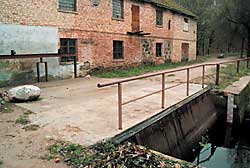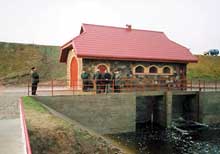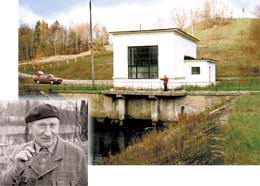
|
POWER INDUSTRY
|
BANKING
|
|
 Latvia had over 800 such water mills one hundred years ago. |
By Tatyana Andreeva (Delovoi Chas)
It is assumed that by the end of 2003, Latvia will have around 160 small hydroelectric power plants in operation. Experts claim that this is normal procedure on the way to developing a decentralized power supply system. But for now, owners of the relatively simple dams are trying to grab as big a profit as possible - and are raking it in at double tariffs. Another of their advantages is that what they do is practically under no form of control.
Inherited from times long past, Latvia has quite a number of
old, run-down mills (in the mid 20th century there were 800 such mills in Latvia).
A handful of enterprising people quickly understood that they could build small
hydroelectric power stations on the foundations of these old mills and watch
as the money flowed by. Renewal of the old mills started back around 8 years
ago. Naturally, initial reconstruction was conducted on only those mills needing
the smallest of investments.
Yet entrepreneurs were frightened neither by the long process of getting approval
for the projects, nor by the expensive costs of constructing the plants (average
costs amount to around 200,000 US dollars). If in 1993 there were only three
small hydroelectric power plants in Latvia, by the end of 2000 the figure was
already at 72. In recent years people have started to build mini plants on very
small rivers. Interest in such plants is connected to the opportunity of selling
surplus power production to Latvenergo, and consequently to the fact
that such stations pay off quite quickly. Construction of a plant with a capacity
of 2-3 kWh costs about 33,000 US dollars; monthly earnings amount to around
10,000 -11,000 US dollars. In the country's eastern region of Latgale, also
the country's poorest region, one businessman built 10 such small plants in
a span of two years. Rumor has it that these plants are owned through offshore
companies by one of Latvia's most influential politicians.
90 permits have been issued for the construction or expansion of small hydroelectric
plants. The combined capacity of small hydroelectric power plants in Latvia
amounts to 8.6 megawatts. Nevertheless, the majority of these river-based rigs
only barely pass off as being called a power plant, because of the low quality
power they produce, power that needs to be boosted from the national grid.
The speedy construction of these small plants was mainly promoted
by one quite significant factor. Regulations adopted by the Cabinet of Ministers
in 1995 stated that Latvenergo would buy surplus electric power from
small power plants at double tariff - for an average of 0.046 dollars per kWh.
The regulation concerns only those plants launched before January 1, 2003 and
only for a period of 8 years after the plants are launched. It has been estimated
that investments towards reconstruction should already have paid off in these
eight years. If in the given time a plant does not prove its profitability,
then it's your own fault: the project thus has no economic grounds. Needless
to say that many soon realized that their investments would bring a return much
sooner than the eight-year period was over.
The amount of electricity Latvenergo, Latvia's power monopoly, may actually
buy up is not all that clearly defined. According to Uldis Mosans, head of the
Economics Ministry's power department, only surplus production can be sold for
double tariffs. The law clearly states that 51% of the electricity produced
at a plant must be used for local needs. And yet it's not all that simple to
measure how much electricity the owners of these plants have actually produced,
or sold for that matter. The best system would be if these tariffs were revised
each year and on an individual basis for each and every plant, according to
the amount of power produced.
This, by the way, does happen in a number of European countries. What's more,
there are even special kinds of subsidies, regulated in fine detail, for building
small hydroelectric power plants.
Mosans believes that the idea of these small plants should also be supported
in the future, especially if they are able to provide electricity for local
inhabitants in case of general grid failure or problems with the lines.
The hydroelectric power stations have their supporters and also
opponents. Interestingly enough, both sides use the same factors to argument
their stance. Owners of the hydro-technical equipment stress that the small
stations don't pollute the environment, and even take part in the purification
of rivers. Purification in the sense that water, after trapped in the dams,
falls through the turbines and gets saturated with oxygen, later promoting biological
processes of self-purification. Other claims go on to say that the hydroelectric
plants and dams make a beautiful view for the aesthetics, meaning that such
places are quite attractive for campers and tourists.
Latvia's Environmental Protection Club believes that the small stations destroy
fish migratory routes and the biospheres drowned by the dams poison the water
and deteriorate the biological environment of the rivers. Nearby areas also
become swampy, and routes for water tourism, fishing, boating, loose their attractiveness,
moving further away from natural landscapes to those manmade.
Zydrunas Damauskas (Lietuvos Rytas)
In Lithuania, 35 small hydroelectric power plants produce 30 million kilowatt-hours of electricity a year. This is approximately one tenth of the electric power produced at only the Kaunas Hydroelectric Power Plant, or 0.02% of all the electric power produced in the entire country. In comparison, small plants in other countries produce around 2% of the electric power.
 Small river dambs bring in the money and water leisure. |
Those engaged in energy production at small hydroelectric power plants often call this business a hobby. They work in the business with excitement - it is a business, as well as a hobby, and a profitable one at that. Luxurious villas frequently sprout around the dams they build these plants on. Many of the small stations built on beautiful rivers or ponds have become recreational sites. This is an independent business - it is better to engage in this than in any kind of trade. "If you have built a power plant, you need not worry anymore: the turbine is churning, and your money flows in; but if you own a shop you have to run around all the time," says Petras Pinus, chairman of the Lithuanian Society of Hydroelectric Power Engineers.
Electric power from the small power stations is bought for quite
a decent price at 0.0445 US dollars for high-voltage lines and 0.056 US dollars
per kWh for low-voltage lines. These rates are quite a bit considering that
domestic consumers in Lithuania pay 0.065 US dollars per kWh, and even export
prices are only around 0.01 US dollars per kilowatt-hour.
According to Petras Pinus, the price for power produced in these small hydroelectric
power plants is comparable to that paid in Europe, where such power plants also
enjoy state subsidies.
Owners of the small hydroelectric plants don't have to pay for using the water;
and another advantage is the very favorable tariff for electricity they produce.
If consumer prices for electric power grow, the purchasing price for power made
at the small hydroelectric power plants will also increase. The cost of producing
one kWh of electricity at the huge Kaunas Power Plant is 0.025 US dollars,
but power produced by the small hydroelectric plants costs between 0.0075 and
0.01 US dollars. Although the owners of the small plants are satisfied with
this price set by the government, they admit that constructing new plants would
no longer be worthwhile at such rates. This is why new plants are being built
only on ponds already dammed up, investments only paying off in around 6 or
even 8 years time. The Society of Hydroelectric Power Engineers has confirmed
that the market for construction in this sector has already been just about
exhausted. But.
Owners of the small hydroelectric power stations are mostly
Lithuanian businessmen, however, Norwegians have also been trying to penetrate
the market. Power in Norway is produced only by hydroelectric plants. The past
year has seen negotiations with a Portuguese and French company on the purchase
of some of these small plants. Swedish companies are also interested in entering
the business.
All of the small Lithuanian electric power plants are privately owned. Around
six months ago the Lithuanian state-owned power monopoly, Lietuvos Energija,
sold its last shares (52%) in Ekoelektra, a company owning seven small
hydroelectric power stations. The shares were bought by the Vaizga oil
company, backed by the chairman of LUKoil Baltija, Ivan Paleychik.
The other shares in Ekoelektra belonged to Pajaras, also owned
by the subsidiary of Russia's oil giant LUKoil. Paleychik says he feels
nostalgic for the small power industry. Firstly, because his profession is a
power engineer, and only 9 years ago he was chief at Lithuania's Mazeikiu
Nafta oil refinery.
A big scandal started three or four years ago when Lithuania's
Minister of Economy, industrialist Vincas Babilius, wanted to banish
private capital from Ekoelektra. His opinion was that Pajaras
had acquired its shares in Ekoelektra illegally. No one needed to ask
why Babilius wanted to push Pajaras out of the market. Babilius was pushed
into dealing with the business and into the Lithuanian power industry by his
former boss - the leader of Lithuania's industrialists and an impressively influential
person in Lithuania, Bronislavas Lubis. Lubis owns a company also working
in the business of small power plants - Achemos Hydrostotys.
Despite his seemingly weighted support, Babilius didn't manage to fulfil the
task and was forced to resign from his ministerial post. And after the last
parliament elections in Lithuania, there was no stopping Paleychik in buying
off the rest of Ekoelektra.
Manager of Ekoelektra, Lionginas Kairus, says investments in reconstructing
old hydro-electric plants or building new ones pays off only in around 10 to
15 years. Renovating an old plant costs about 375,000 US dollars. And as there
are no dams left free, there is also no place constructing any new ones.
For these reasons Kairus believes that no-one will really try to get into the
relatively small business, a business, one might add, that is more for padding
the wallets of a small chosen few.
Hannes Tamme (Radio Ku-Ku)
Estonia stopped using small hydroelectric plants in the beginning of the Sixties. Ten years ago, Voldemar Enno, a power engineer who worked in a kolhoz farm fixed up a small and old hydroelectric power plant on the River Ahja. A new phase started in the existence of Estonia's small power stations.
 Old Enno has no lack of energy. |
"It was hard to get the various permissions, but Eesti Energia
supported me greatly at the time," Voldemar Enno told the BC. In 1991 he signed
a contract with Eesti Energia, which promised to buy electric power from
him at a price 13% lower than the average consumer price: "At first I earned
4.35 kopecks per kilowatt."
Enno, a 70-year-old power engineer has worked in different positions within
the Estonian power system, developing his career from a simple worker to the
chief power engineer of an agro-industrial complex in Estonia's region of Pilva.
He was personally acquainted with many officials in the power industry; and
thus had the opportunity to acquire a private hydroelectric power plant for
himself.
At present Enno owns five small plants: Saesaare, Leevaku, Lotka, Raapina, and
Kunda. All of them are situated on small Estonian rivers, on dams once already
boasting hydroelectric plants in the past. Enno either renovated the old ones
or constructed new turbines, and altogether invested more than 4 million Estonian
kroons (over 220,000 dollars) in his business. But he does not intend to stop
at this; his plans include constructing another couple of plants in southern
Estonia.
Small hydroelectric power plants have become very profitable, as Eesti Energia
pays 90% of the average consumer price for each kilowatt of this so-called alternative
power (i.e. 0.05 dollars per kWh). "Eesti Energia settles accounts with
me very properly, and I invest this money in the renovation of old plants,"
admitted Enno, a fanatic. In mid-July I met him on the river Vihandu, where
he and his friends were cleaning out the riverbed, allowing the water to flow
better. This old man has no lack of energy.
In 1992, Estonia adopted a program for economizing power. One
of the basic conclusions the authors of the program came to, is that Estonia
must reduce importing various fuels. The result of this was that by 1998, heating
oil, oil products and coal imports had halved. There is a steady growth in demand
for local fuel materials - wood, sawdust, bark, and peat, as well as wind and
solar energy. According to expert predictions, alternative energy sources in
Estonia should account for 13% by 2010.
A new public program for energy saving was launched in January 2000. Estonia's
government believes that it is possible to consume less power than it is at
the moment. On average, every Estonian family spends 12% of its salary on electricity.
At the same time, families in the European Union spend only between 2 and 3%.
In addition to the five private hydroelectric stations that
belong to Voldemar Enno, another one is situated on the River Poltsamaa by Vaike-Kamari
boasting a capacity of 200 kW; another is located in southern Estonia, on the
River Tudulinna with a 100 kW capacity. There are around another ten very small
stations across the country with capacities of 10-30 kW. Most of them are in
southern Estonia where the rivers are rich with waterfalls and rapids.
Yet another promising sphere for producing alternative power is developing wind-powered
generators. Windmills of such kind with a capacity of 150 kW have been producing
power on Estonia's Hiiumaa Island for the past ten years. Saaremaa Island has
another two windmills with two more near the city of Haapsalu. Even Tallinn
has a windmill, built by the city's shipyard in cooperation with the Tallinn
Technical University.
Tartu Agricultural University (TAU) has organized two conferences on
wind power and other alternatives replacing combined heat and power engineering.
"We carried out research and now we are working on a program for the consumption
of wind power in all the Baltic States, and we think that the opportunities
for this are very good," - the BC was told by a scientist of TAU, Valdur Tiit.
According to what he said, the program will be ready by the end of this year.
"If one wind-powered generator is placed per every area of 200 square kilometers,
this would be enough to supply the whole of Estonia with electric power, and
the environment would stay clean," said Tiit. It seems that similar prospects
look promising. Denmark's REG has already taken an interest in building
several wind generators in western Estonia.
Nevertheless, Estonia cannot manage this without facing certain problems also related to power market competition, just as anywhere else in the world. Eesti Energia has lately refused to buy electric power produced in peat-burning plants at the government set price. A similar situation developed with joint - stock company Sangla Turvas (near Tartu) and Tootsi Turvas (near Pernu). "There is a law, but we don't have the feeling that alternative energy in Estonia has got the green light quite yet," says chairman of Tootsi Turvas, Lai Maelet.
|
POWER INDUSTRY
|
BANKING
|
|